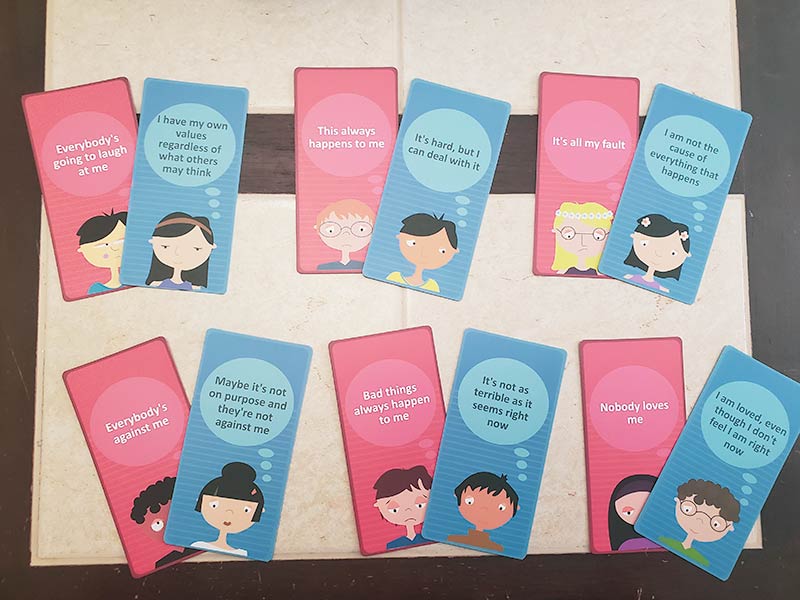Positive Self-Talk for Kids – Teach Your Child to Say “I Can” Instead of “I Can’t’
What’s inside this article: An overview of self-talk, how to develop positive self-talk for kids, and minimize negative self-talk. Benefits, teaching strategies, activities, and printables to help your child develop positive thinking skills.
Disclaimer: This post contains affiliate links.
Self-talk plays a vital role in:
- Planning
- Problem-solving
- Self-esteem
- Critical thinking
- Emotions
- Self-Image
Positive self-talk is an effective strategy for helping kids improve their confidence and self-esteem. It helps children overcome negative thought patterns and replace those thoughts with more positive, realistic ones.
In this article, I am going to teach you how to develop positive self-talk skills for kids. I also provide you with some helpful activities to get your child started on their journey to positive thinking.
What is Self-Talk?
Most people have some form of an internal monologue or inner voice that provides ongoing verbal or visual thoughts. That monologue is your self-talk; it’s sometimes called a stream of consciousness.
The nature of your self-talk is what determines if it’s positive or negative.
Having preconceived ideas that you aren’t good enough, being overly critical of yourself, and having unhelpful thoughts in stressful situations, is considered negative self-talk.
How we feel and think about ourselves begins developing in childhood, and the earliest self-talk our children have is a reflection of feedback they receive from others, caregivers, and peers.
Positive self-talk involves seeing the reality of a situation and thinking about yourself with compassion and kindness. It’s not just about optimism but about having thoughts that help you through difficult situations rather than putting yourself down further.
Coping self-talk is a specific form of positive self-talk that helps you overcome stressful situations. It can be a helpful self-regulation strategy when explicitly taught to your child.
An example of coping self-talk is, “Amy, I know you’re upset about your grade on the math assignment. You did your best. You can go over your mistakes with the teacher after class, so you’re more prepared next time.”
Notice that with coping self-talk, you are referring to yourself in the third person. Research suggests that talking to yourself this way helps you better separate your emotions from your thoughts, making it easier to think realistically.
Benefits of Positive Self-Talk for Kids
- Improves self-regulation: Data reviewed from seven separate studies concluded that self-talk influences self-regulation. These studies found that self-talk impacted the ability to regulate thoughts, feelings, and behavior under stress. Children practicing positive self-talk and coping self-talk can more effectively regulate their emotions and behavior.
- Improves self-esteem: using positive self-talk regularly builds confidence and fosters a growth mindset, helping kids build high self-esteem. Research also shows that kids who frequently use negative self-talk are more likely to experience anxiety and depression and that anxiety levels decrease with positive self-talk.
- Leads to better academic achievement: A study found that positive self-talk improves learning by assisting with the concept of ‘chunking’ complex information, which helps you recall and carry out complex tasks accurately. Another study found positive self-talk improves students’ performance on math assessments.
Discouraging or Minimizing Negative Self-Talk
Is your child stuck in a pattern of constantly putting themselves down?
Before you can begin teaching positive self-talk, you first need to identify how often and what type of negative self-talk your child engages in. With a better understanding of their thinking, you can use strategies to minimize the negative self-talk.
Negative self-talk typically falls into one of the following categories:
- Personalizing – Blaming themselves every time something goes wrong.
- All or Nothing – Only seeing things as good or bad. There is no gray area.
- Disqualifying the Positive – Dismissing the positive from every situation and focusing solely on the negative
- Emotional Reasoning – Concluding that your emotional reaction to something makes that thing become a reality.
- “Should” Statements – Negative self-talk that includes the word should, “I should be able to do this..”
- Catastrophizing or Over Generalizing – Always expecting the worst to help.
- Self-limiting statements – Thoughts such as “I can’t handle thing”, “This is impossible”.
You can read about these negative thinking patterns in more detail here.
Remember, your child’s brain is used to thinking a certain way and won’t change overnight. Teaching positive self-talk skills to kids will be a gradual process with long-term benefits.
Discuss Self-Talk with Your Child
The first step to minimizing negative self-talk, and increasing positive self-talk, is teaching your child what self-talk means.
Reading books or online resources together can help your child understand what self-talk means. There are several illustrated books available that you can use as a teaching tool.
- Positive Me!
- Your Thoughts Matter
- How to Get Unstuck from the Negative Muck
- 12 Annoying Monsters: Self-Talk for Kids with Anxiety
- The Magic is Inside You
Identify Negative Self-Talk Traps
In what situations is your child most likely to engage in negative self-talk? Identifying these “traps” ahead of time can help you prepare.
What positive self-talk statements can your child practice instead?
Does your child always put themselves down before a test? If you notice they say things like “I should be able to do this math, everyone else can” or “I’m so stupid, I’m never going to pass anyway,” then tests are a negative self-talk trap for your child.
Use Positive Affirmations
Positive affirmations are specific, simple statements that you repeat to yourself (often) to provide yourself with encouragement or motivation.
They’re usually spoken in the present tense, directed toward yourself, and use positive words. For example: “I can…” or “I am….”
Research shows that positive affirmations boost self-esteem and help your child develop a positive mental attitude, helping them develop a growth mindset and a positive outlook on life.
Using positive affirmations can also help your child overcome negative self-talk.
Learn more about positive affirmations here. You can also use this free printable activity.
Positive Affirmation Activity SheetCBT Based Games
CBT is a talk-based therapy, which is often challenging for children. But, CBT-based games are play-based games, on the other hand, more effectively help children develop skills that cognitive behavior therapy teaches.
There are many different CBT-based games; one we use personally is Playing CBT.
Playing CBT challenges kids to:
- Look at their thoughts and feelings more objectively
- Change their negative thinking patterns into positive ones
- Recognize unrealistic thoughts and change them.
- Change behaviors that are interfering with everyday life

Activities that help your child better understand their feelings is also beneficial because the more they understand about themselves, their emotions, and why they feel and think the way they do, the most self-compassion and understanding they’ll have.
Help Your Child Identify Their Strengths
Everyone, no matter who you are, has strengths and challenges. Some strengths are easy to notice, and some are more subtle.
Helping your child identify their strengths is a great way to boost their self-esteem. With increased confidence, you can also coach your child on using their strengths to help overcome some of their challenges.
They can remind themselves of their strengths when using positive self-talk. For example, “This is taking a long time, but I am a patient person. I can handle it.”
This free activity can help your child recognize their strengths:
Strengths and ChallengesThe Imaginary Best Friend Activity
This is a way to challenge negative self-talk. When your child says negative things about themselves, try asking some of these questions:
- Would my friend say or think this about me?
- Would I say or think this about a friend?
- What would a friend say about me instead?
- What would I say to a friend who believed this about themselves?
The answers to these questions can help create new positive self-talk phrases for your child.
Teach Your Child About Being Kind to Themself
One of the most important things kids should know about kindness is that you must also be kind to yourself.
How many of us are too hard on ourselves when we make mistakes? Or, always end up putting ourselves and our own needs last?
Being kind to yourself teaches your child to have compassion, and take care of themselves, which helps them develop a positive inner monologue.
- These Kindness narratives have a section on being kind to yourself
- Teach your children to know how to stand up for themselves and set their own boundaries with assertive communication.
- Eating healthy and drinking enough water are both important parts of being kind to yourself. When you take care of your body, you feel better. Find some great tips here.
- Teach kids about consent and bodily autonomy. It is their right to be safe, and essential to know that being kind to yourself might mean saying no to someone else. Saying no isn’t necessarily unkind. Here are five great children’s books about consent.
Positive Self-Talk Statements
Here are a few examples of positive self-talk statements you can use to model positive self-talk to your child and to help them create their own positive self-talk.
- This took courage and I’m proud of myself for trying.
- I am a work-in-progress, I’m growing and changing every day.
- I may not be able to control this situation, but I am in charge of how I respond.
- It’s okay to feel how I feel. Emotions are normal, and this will pass.
- Tomorrow is a fresh start.
- Sometimes things don’t go according to plan, but there are plenty of positives; I won’t let this ruin my day.
- There is always a solution; I just haven’t thought of it yet.
- This is hard, but it’s challenging me to try my best.
- If I can’t overcome this obstacle on my own, I can ask for help.
- Everybody feels scared/angry sometimes, I can move past this.
Remember, you can’t change the way you think overnight. When our brains are used to thinking a certain way, it’s very difficult to overcome.
However, you can help your child, gradually, to use more positive self-talk and minimize the amount of negative self-talk with the strategies mentioned in this article.

